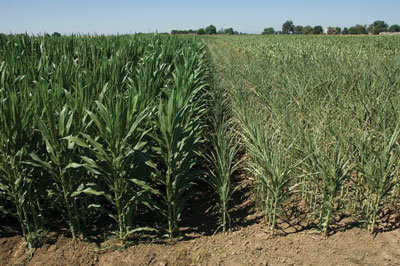
Irrigation
Drought-proofing corn
Corn is a bit of an anomaly through most of Western Canada. Granted, there are some places, like the Red River Valley, where adequate rainfall and heat team up to provide suitable corn-growing conditions.
May 4, 2009 By Editorial Staff
Corn is a bit of an anomaly through most of Western Canada. Granted, there are some places, like the Red River Valley, where adequate rainfall and heat team up to provide suitable corn-growing conditions. But in most areas across the Prairies, it is too dry for this potentially lucrative crop to scratch out an existence. “Producers usually put corn into their rotation for cash crop reasons,” says Pam de Rocquigny, business development specialist, feed grains, with the province of Manitoba, based in Carman. “They can grow it and grow it well. They get good yields and even if the price is low, it’s still a valuable part of their rotation.”
 |
| Drought tolerant hybrids are selected from managed moisture stress environments at Pioneer Hi-Bred’s year round testing facilities in California, Colorado and Chile. Photo courtesy of Pioneer Hi-Bred. |
However, moving out of the Red River Valley means conditions tend to dry out, and while there is enough heat to grow corn, moisture is usually the limiting factor. But what if scientific advancements could change all that? “Growing corn in the western part of Manitoba where there is less moisture may be a fit,” says de Rocquigny. “Those growing sunflowers already have row crop equipment, so growing corn would not be a jump.”
Pioneer Hi-Bred, a seed company that develops corn hybrids around the world is working to increase drought toleance in corn. Its research and development focuses on a number of areas.
All products in Pioneer Hi-Bred’s lineup are tested and characterized, meaning every yield test and research
location trial completed across North America is evaluated, ranked and scored for drought tolerance. “The timing of water stress in the growing season is very important. It makes a big difference whether the plant is stressed when knee-high, at the flowering stage or at grain fill,” says Dr. Steven King, senior research manager with Pioneer Hi-Bred. “The timing of the stress impacts how the corn responds. During its growth and development, corn is most sensitive at flowering, when the plant tassels and sheds pollen. If the plant is exposed to drought stress at this time, it will have a direct impact
on yield.”
To further evaluate hybrids under drought conditions, Pioneer Hi-Bred has set up special sites called “managed stress environments.” These locations are in California, Colorado and Chile where there is very little natural rainfall so the timing and severity of the water stress can be managed very precisely through irrigation. By growing corn hybrids at these managed locations and comparing their performance to known checks, researchers can see which genetics perform under water stress.
While hybrid characterization and managed stress environments are both short-term approaches, molecular breeding is another technology being used to tackle improved drought tolerance. “Molecular breeding identifies segments of corn DNA that are beneficial to drought tolerance,” says King. “It is kind of like finger-printing. We are tagging certain genes, then tracking that DNA in our breeding population. We make sure we select the hybrids that have the DNA for drought tolerance.”
Longer-term transgenic solutions including genetic modification may also open doors to drought tolerant corn. Potential drought genes from a variety of different plants other than corn are first-identified for further analysis.
Thousands of genes are evaluated in the lab and a quick assay is completed to identify ones that have potential. Selected genes are then inserted into corn hybrids. These transgenic plants are evaluated in the greenhouse. When growing plants in pots in a greenhouse, the amount of water can be precisely controlled and the plant’s tolerance to drought stress evaluated. This is a “whittling down” process, in which genes that are not working effectively are discarded.
Once a few select “candidate genes” are identified, they are tested in an outdoor managed-stress environment with limited irrigation. If the plants with the candidate genes show potential in this situation, the next step is to evaluate the genetics in research test plots and farmer strip trials. “There are a lot of good candidate genes in our pipeline and we are hoping to bring our customers a transgenic approach to drought in the next four to six years,” says King.
King explains that the key point for drought tolerance technology in corn is that yield potential cannot be sacrificed when breeding in drought tolerance. “We cannot predict when drought will come or how severe it will be, so the hybrids that are going to carry the drought tolerance gene also have to be the top yielders in situations when there is plenty of water,” says King.